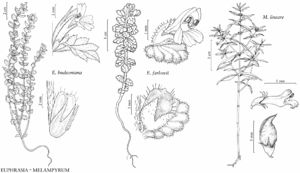Difference between revisions of "Euphrasia hudsoniana"
Rhodora 17: 194. 1915.
FNA>Volume Importer |
FNA>Volume Importer |
(No difference)
| |
Revision as of 18:32, 24 September 2019
Stems simple or branched, to 35 cm; branches 1–5 pairs, from distal cauline nodes; cauline internode lengths (1–)2–5 times subtending leaves. Leaves: blade lanceolate to ovate, 5–12(–16) mm, base strongly cuneate, margins serrate to incised-serrate, teeth 1–5 pairs, apices subacute to acute. Inflorescences beginning at node 2–9; proximal internode lengths 1–2.5 times bracts, distal shorter than bracts; bracts green, sometimes purplish adaxially, broader than leaves, elliptic to ovate, length not more than 2 times width, 7–15(–20) mm, base strongly cuneate, surfaces +/- hirsute and hairs eglandular, teeth 2–6(or 7) pairs, as long as or longer than wide, apices acute, sometimes aristate. Flowers: corolla white, adaxial lip tinged lilac, 5–6.5 mm, lips +/- equal. Capsules narrowly oblong, 4–7.5 mm, apex truncate to emarginate.
Phenology: Flowering summer.
Habitat: Gravelly, sandy, grassy, and rocky places, often calcareous, coastal or shores of streams and lakes.
Elevation: 0–200 m.
Distribution
Alta., Man., Nfld. and Labr. (Labr.), Ont., Que., Mich., Minn.
Discussion
Euphrasia hudsoniana has been reported from Alberta; the voucher specimen supporting that occurrence has not been verified by the author.
The status of var. contracta P. D. Sell & Yeo and var. ramosior P. D. Sell & Yeo is unclear. Some specimens identified as var. contracta represent precocious states of var. hudsoniana. Variety ramosior specimens look very different from typical var. hudsoniana, resembling the hybrid Euphrasia nemorosa x E. hudsoniana. But variation in their characters is consistent, particularly their minute corollas and type of pubescence, which is not typical of Euphrasia hybrids.
Selected References
None.
